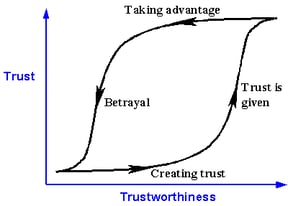Among the most fascinating phenomena we have studied is the concept of hysteresis. Bear with us since this applies in spades to business and relationships.
Hysteresis refers to the lag in a variable property of a system with respect to the effect producing it. Think of a thermostat that doesn’t kick in until the temperature drops a few degrees below the target setting. A hysteresis loop describes the fact that many reversible processes are not symmetrical.
For example, consider the human process of trust. Trust is hard to gain and easy to lose. It usually takes a while to build trust with employees, among team members or with customers.
Unfortunately, it doesn’t take much to lose that trust – often only one or two unfortunate incidents will reset attitudes. Worse still, once trust has been broken by a missed commitment or betrayal, it takes even longer to restore it to its previous level.
One heuristic states that for every one failure, we have to demonstrate five positive behaviours to begin to recover trust. And recovering from a second failure is almost impossible. As they say, “Fool me once, shame on you. Fool me twice, shame on me”.
Why does this matter? Well, in any organization trust between colleagues is the foundation of business performance because it is directly related to empowerment. We will play our position on the team because we trust you will play yours.
With trust, the speed of implementation goes up and the cost to get things done goes down. Decisions can be made more quickly. There is less likely to be duplicated effort and more likely to be innovation.
This also applies to customer and partner relationships. With trust, negotiations are easier, decisions get made faster and both parties benefit from greater collaboration. Any good salesperson understands this and works hard to earn and preserve the trust of her clients.
It’s easier to keep an existing customer (or employee) than to find a new one – because the trust is already there.
The moral of the story is to think twice before taking actions that could damage relationships. As business people we are often forced to make the trade-off between short term gain and long term relationships.
Do we give a margin-destroying customer discount to compensate for poor service or a delivery error? Do we forego employee salary increases in order to meet our earnings targets? Do we push some cost over to a partner or customer in order to reduce our own? Do we limit the number of participants in our program or event to control our costs? In all cases we’re putting our self-interest ahead of our partner’s. It won’t be long before our partner gets the message and our relationship is impacted accordingly.
Any good relationship can absorb some selfishness, but the effect is cumulative and can reach a tipping point unexpectedly. Once you’ve fallen off that cliff, it’s a long slow climb back up the mountain to regain your position of trust.
This article was published more than 1 year ago. Some information may no longer be current.


